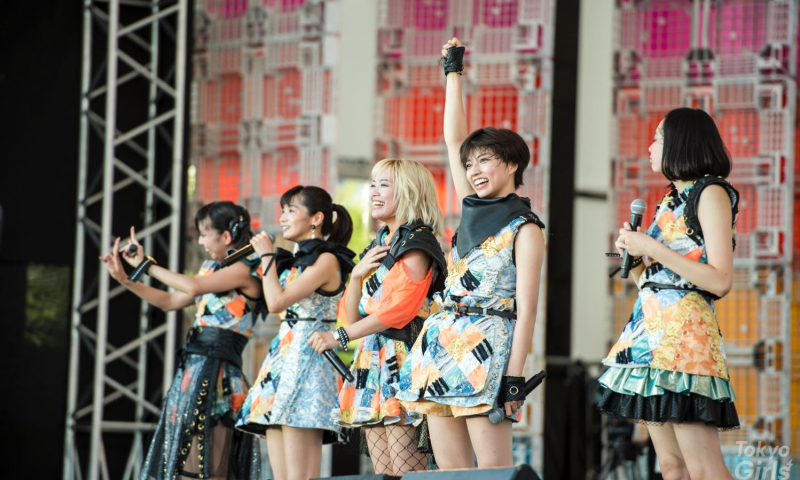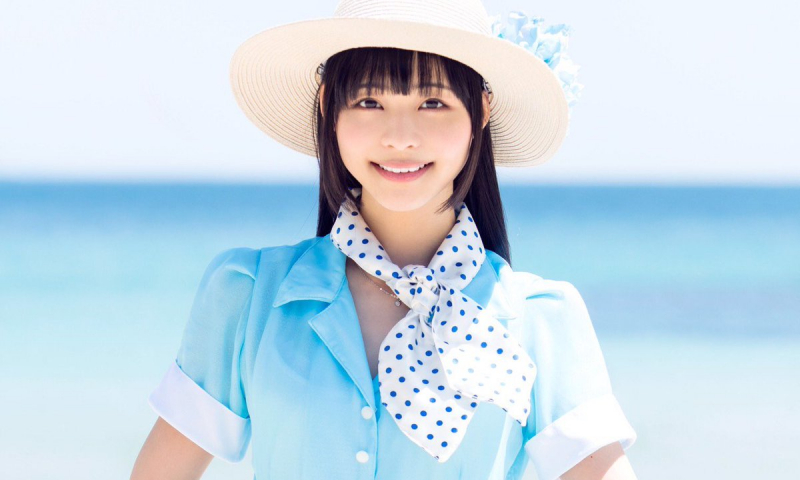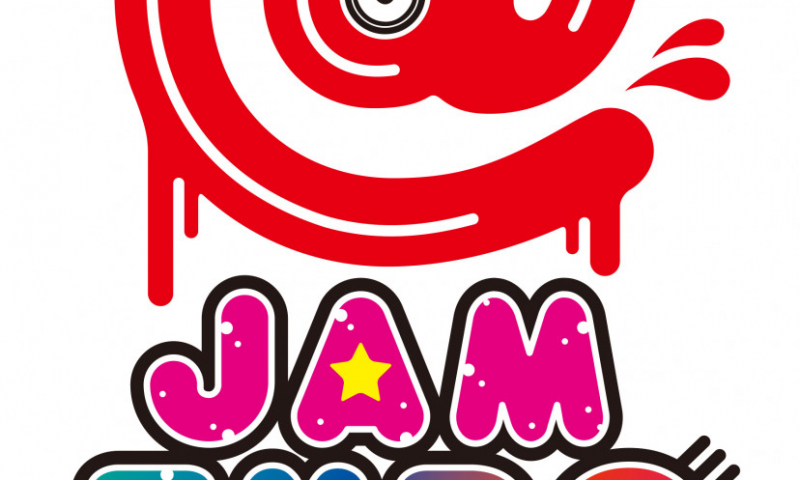
@JAM EXPO 2018 Announced with Host Yufu Terashima!
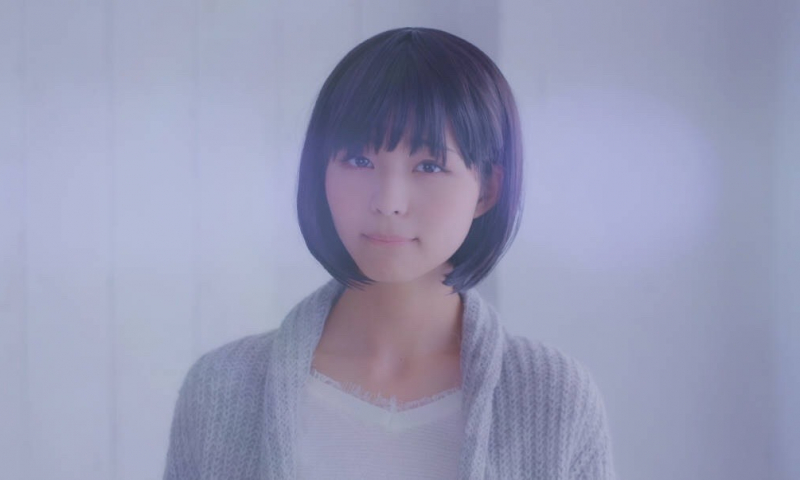
Yufu Terashima, known as Yuffie, and her love (which borders on crazy) for local mascots, or yurukyara, has manifested in the form of her new single, “Iyahaya Feeling”. The new song with ten-member local mascot unit Terashima Yufu with Yuruffis will be released on November 11th.
「ゆっふぃー」こと寺嶋由芙のゆるキャラへの(限りなく狂気に近い)愛情は、とうとう「いやはや ふぃ〜りんぐ」という彼女のニュー・シングルを生み出しました。10体ものゆるキャラとのユニット「寺嶋由芙 with ゆるっふぃ〜ず」名義による新曲が11月11日にリリースされます。
We first found out about Yufu Terashima’s love for local mascots when she was a member of BiS. Then, after leaving Bis in 2013, she became a solo idol and started appearing more often as head MC of local mascot events. She was even head presenter for one of the largest local mascot events, the Yurukyara Grand Prix. On top of that, she also served as a local mascot attendant for the TOKYO MX broadcast of Jun Miura & Hajime Anzai no Yurukyara ni Makenai!
寺嶋由芙は、BiSに在籍していた時代からゆるキャラが大好きなことで知られていました。そして、2013年にBiSを脱退した後、ソロアイドルに転身した彼女は、ゆるキャラのイベントでMCを担当することも増えました。ゆるキャラ関連のもっとも大規模なイベントのひとつである「ゆるキャラグランプリ」でも、寺嶋由芙は司会を担当しています。また、TOKYO MX系で放映されている「みうらじゅん&安齋肇のゆるキャラに負けない!」では、彼女がゆるキャラのアテンドを担当しています。
Not all Japanese are people are familiar with local mascots. However Yufu Terashima fans, called “Yuffie-ists”, who read her blog are inevitably exposed to an exorbitant amount of local mascot information. You could even say her style of “educating” her Yuffie-ists is actually closer to “brainwashing” them.
日本人ですら誰もがゆるキャラに詳しいわけではありません。しかし、寺嶋由芙のファンである「ゆふぃすと」は、彼女のTwitterやブログを読むと、必然的に大量のゆるキャラ情報を目にすることになります。ゆふぃすとは、「洗脳」に近い形で「教育」されていきます。
When Yufu Terashima talks about local mascots, she starts talking faster than usual and you can hear the tone of excitement in her voice. We decided to ask her what exactly it is about the appeal (or magic) of local mascots that has captivated her so much.
寺嶋由芙は、ゆるキャラについて語るとき、ふだんの取材よりも早口になり、口調は熱を帯びます。彼女をここまで虜にするゆるキャラの魅力(あるいは魔力)について、私は話を聞くことにしました。
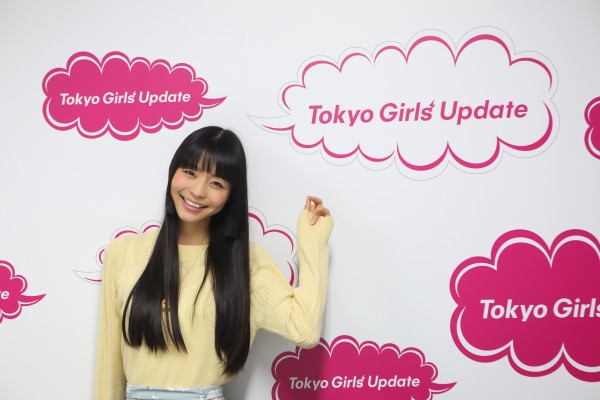
– Regarding “Iyahaya Feeling”, was there a different reaction among idol otaku and local mascot fans?
——「いやはや ふぃ〜りんぐ」に対して、アイドルオタクとゆるキャラファンで反応の違いはありますか?
Yuffie: Local mascot fans were really pleased. They were glad to see local mascots that they usually wouldn’t be able to see, because of how far away the areas they represent are, collaborate together. Otaku fans mostly commented that, “As long as you’re having a good time that’s what’s most important.” or “Seeing my favorite idol happy makes me happy, too.”
ゆるキャラファンはとにかく喜んでくれています。地元が遠いキャラクター同士のなかなか見られないコラボを喜んでくれています。オタクは「寺嶋由芙さんが幸せそうで何より」という感じで、「推しのアイドルが喜んでいるのが自分の幸せだ」と言ってくれていますね。
– So it was kind of the opposite of what you said before about, “If my otaku fans are happy then I’m happy,” right?
——ゆっふぃーは以前は「オタクの幸せが自分の幸せ」と言っていたのに逆転していませんか?
Yuffie: It is. (laugh) When they saw how much I was grinning in the MV, they were happy, but a little sad, saying, “You look different there than you do with us.” (laugh) There were also otaku fans looking forward to seeing me pictured together with local mascots and looking like an otaku myself.
逆転しました(笑)。MVでも私が素でニヤニヤしていたので、「俺たちといるときと違う」って、せつなく喜んでくれたり(笑)。私がオタクの表情をしているので、ゆるキャラと私のツーショットを楽しみにしてくれているオタクもいます。
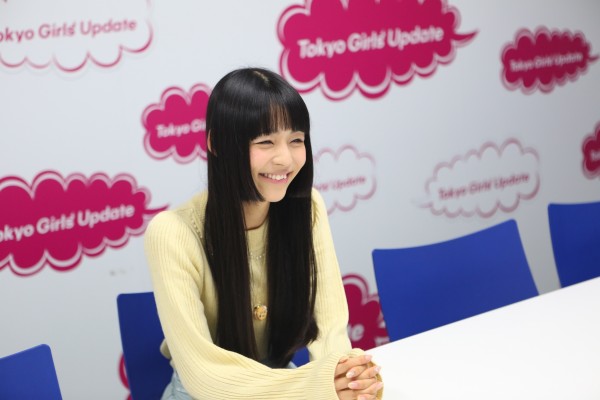
– Speaking of which, it’s usually free to go and see local mascots. Is the culture there a little different from going to see idols?
——とはいえ、ゆるキャラの現場は基本的に無銭ですよね。アイドルの現場とは文化的にかなり違うのでは?
Yuffie: That’s a really difficult one. Local mascots are doing PR for their local areas, so they allow you to take as many pictures as you want, but there are people who buy my CDs so they can take a picture with me, so the boundaries is a little difficult. But otaku fans understand that there’s this type of culture when seeing local mascots, or this type of culture when seeing idols, so I hope that more local mascot fans can understand that as well and hopefully will come to see my concerts? Right now it’s free to take pictures during the release event, but after “Iyahaya Feeling” is released and we’re doing the Tomei Osaka tour, I want to slowly try and find a way to encourage local mascot fans to buy tickets. I wonder if it will be easy for local mascot and idol fans to come together for the tour and the solo concert? I’d like to make a “bring your friends to a show” day. (laugh)
それはすごく難しいところです。ゆるキャラは地域のPRなどをしているので、知ってもらうために写真も撮り放題だけど、私はツーショットを撮るためにCDを買ってくれる人もいるので、境界線が難しいです。でも、オタクは「ゆるキャラのときはこういう文化、オタクはこういう文化」とわけてくれているので、ゆるキャラファンにも理解してもらえたら、もっと私のライヴに来てくれるのかな? 今はリリースイベント中で撮影フリーだけど、「いやはや ふぃ〜りんぐ」をリリースした後の東名阪ツアーは、ゆるキャラファンにもチケットを買ってもらいやすい導線を作りたいと考えています。ツアーやワンマンライヴが、ゆるキャラファンもアイドル現場に踏み出しやすい日になるのかな? オタクは「友達をアイドル現場に誘う」ということに踏み出す日にしてほしいです(笑)。
– Are there local mascots overseas?
——海外にはゆるキャラはいるのでしょうか?
Yuffie: Not really; there are a few at embassies and tourism organizations, but for the most part they’re a Japanese thing. There’s Shalo-um chan at the Israeli embassy and Saipanda! (A play on “Saipan”, “panda” and the phrase “Saipan da!” which translates to “This is Saipan!”) in Saipan, but they’re mostly there to appeal to Japanese people. I haven’t found any local mascots in New York. (laugh)
海外ではあまりいなくて、大使館や観光協会とかにいることもあるんですけど、だいたい日本人が絡んでいるんです。イスラエル大使館の「シャロウムちゃん」やサイパン島の「サイパンだ!」もいるけれど、日本人向けなんです。ニューヨークのゆるキャラとかは見つけらてないです(笑)。
– On the other hand, why do you think there are so many local mascots in Japan?
——逆に、なぜ日本ではゆるキャラがこんなにいるのでしょうか?
Yuffie: Jun Miura once said, “Because Japan has a culture of 8 million gods, it’s easy to turn anything into a character here.”
みうらじゅんさんは「日本が八百万の神の文化だから、何にでも目鼻をつければキャラクターになりやすい」と言っていました。
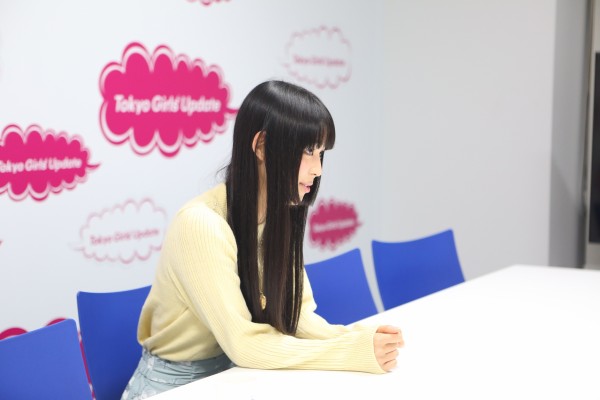
-What do you think the differences between mascot characters and local mascots are?
——そもそも、マスコットキャラクターとゆるキャラの違いはどこにあるのでしょうか?
Yuffie: Originally local mascots (yurukyara) were created to become mascot characters. There’s even mascots for Japanese baseball teams. But Mr. Miura noticed that local mascots are strange ones that local governments have created. At first there was some backlash against calling them “yurukyara” (literally, a “weak mascot character”), but that changed after cute characters like Hikonyan (the local mascot of Hikone, Shiga prefecture) started coming out. There’s a distinction between “before Hikonyan” and “after Hikonyan”. (laugh) Mr. Miura also noticed that until then, only those in the know knew about them. He felt there were a lot of local government characters that were like, “What kind of design is this?” and he began buying and collecting their items.
ゆっふぃー ゆるキャラも、もともとはマスコットキャラクターのつもりで作ってるんですよ。日本には野球の球団のマスコットキャラクターもいますし。日本の地方自治体が作っておかしくなっているのがゆるキャラで(笑)、みうらじゅんさんが目をつけたんです。最初は「ゆるキャラ」という言われ方に反発もあったけど、「ひこにゃん」(滋賀県彦根市のゆるキャラ)のようなかわいいキャラクターが出てきて変わったんです。「ひこにゃん以前、以後」という区別があるんですよ(笑)。それまでは、みうらじゅんさんが目をつけていた「知る人ぞ知るもの」だったんです。地方自治体には「そのデザインはどうなの?」っていう感じのキャラクターが多くて、みうらじゅんさんがグッズを買い集めていたんです。
– Did you begin to like local mascots before Hikonyan or after Hikonyan?
——ゆっふぃーがゆるキャラを好きになったのは「ひこにゃん以前、以後」のどちらですか?
Yuffie: I only became aware of local mascots after. My area has a garbage collection character and I started to like it because it struck me as “Cute!” but it was a feeling only my mother and I shared. (laugh) Even my friends were like, “Why do you care so much about it?” and it went over their heads, but after Hikonyan people started talking about it more and I was grateful. After Chiba-kun (Chiba prefecture’s local mascot) came out when I was in high school, everyone started paying attention to weak mascots. After Hikonyan, local mascot designs became simpler. Until then they incorporated specialty items from that area. Like Fukka-chan (Fukaya, Saitama prefecture’s local mascot) has leeks growing out of her head and a cute face.
ゆるキャラを認識したのはひこにゃん以後ですね。地元にもゴミ収集のキャラクターがいて、「かわいい!」と好きだったけど、その感覚を共有できるのは母親しかいなくて(笑)。友達も「なんでそんなのに気がつくの?」ってスルーだったけど、ひこにゃん以後は話が広がるようになったのでありがたいです。「チーバくん」(千葉県のゆるキャラ)が高校生のときに出てきて、みんながゆるキャラのかわいさに気づいてくれるようになりました。ひこにゃんからゆるキャラのデザインも「引き算」になったんです。それまでは、ゆるキャラには特産品が詰めこまれていたんです。「ふっかちゃん」(埼玉県深谷市のゆるキャラ)も、頭にネギが生えているけど、顔はかわいいんです。
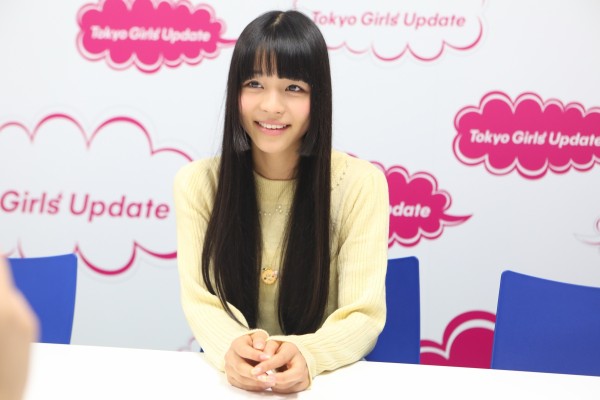
– How are Japanese local mascots and characters overseas different?
——海外のキャラクターは、日本のゆるキャラとどこが違うのでしょうか?
Yuffie: Characters like Mickey Mouse are very expressive. I think some people find the way some major Japanese characters have no expressions scary, and that this is one cultural difference.
ミッキーマウスも表情が豊かなんですよね。日本の無表情で大きいキャラクターを恐いと思う人もいるし、それは文化の違いだと思います。
– But, for example, isn’t Kitty-chan (Kitty White/Hello Kitty) popular overseas?
——たとえばサンリオの「キティちゃん」(キティ・ホワイト)は海外では人気があるのでしょうか?
Yuffie: She is. There’s something fashionable about her, and I’d be glad to see more characters follow in Kitty-sempai’s footsteps.
あります。キティちゃんはおしゃれな要素があるので、「キティ先輩」が切り開いた道を他のキャラクターが行ってくれたら嬉しいです。
– And you say that because? (laugh)
——どういう立場からの発言なんですか(笑)。
Yuffie: Because it’s like that. (laugh) Sanrio characters are much different because they aren’t promoting any local area. Pom Pom Purin and Gudetama are popular with Asians, who often believe that “yellow things bring good luck”. There are three different Pom Pom Purin café locations, and I also saw people from overseas at them. There are a lot of overseas visitors at the Sanrio Shop, too. But the Sanrio Shop is an actual store, where as it would be more difficult for foreign visitors to purchase local mascot items when they come to Japan, and not very much information about local mascots reaches those overseas.
そういう立場です(笑)。サンリオのキャラクターは「ご当地」を背負っているわけではないのは大きな違いです。「黄色いものは縁起がいい」と言われているアジアの人には、「ポムポムプリン」や「ぐでたま」が流行っているそうなんです。「ポムポムプリンカフェ」は3か所あって、店内で海外の人も見かけました。「サンリオショップ」も海外の人が多いです。ただ、サンリオショップなら常設だけど、海外の人が日本に来たときにゆるキャラのグッズを買おうとしても難しいでしょうし、ゆるキャラの情報を海外に発信できたらいいんじゃないかなと思います。
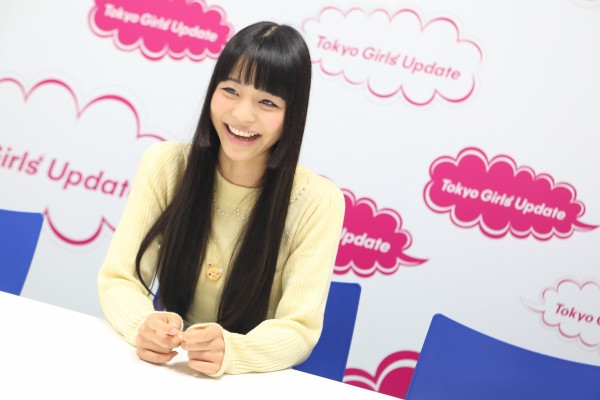
– How about you help us start a “Tokyo Yuruchara Update” section on Tokyo Girl’s Update? Is there a certain character you’re cheering for in the Yurukyara Grand Prix? Because there are so many active local mascots, from the outside it seems like it would be hard to just cheer for one.
——「Tokyo Girls Update」に「Tokyo Yuruchara Update」も開設してもらいましょう。開催中の「ゆるキャラグランプリ」でゆっふぃーが応援しているゆるキャラはいますか? いろんなゆるキャラと仕事をしている立場上、表だって応援しづらい面もあると思いますが。
Yuffie: Well because I’m doing Yuruffis it’s a lot easier, and I’m cheering for our members Fukka-chan, Unari-kun (Narita, Chiba prefecture’s local mascot), and Shinjo-kun (Susaki, Aichi prefecture’s local mascot).
でも「ゆるっふぃ〜ず」をやっているから応援しやすくなって、メンバーのふっかちゃん、「うなりくん」(千葉県成田市のゆるキャラ)、「しんじょう君」(高知県須崎市のゆるキャラ)を応援しています。
– So out of ten characters, only three are in the Yurukyara Grand Prix?
——10体いるのに3体しか「ゆるキャラグランプリ」に出場していないんですか?
Yuffie: Well, the reason why the other seven aren’t participating is because some of them were like, “Even though we turned down participating, we’d like to cheer on and vote for Fukka-chan.” Fukka-chan is working hard to make this year her last go at it.
7体がなぜ出ていないのかというと、「自分が辞退してでも、ふっかちゃんを応援したい、ふっかちゃんに僕の票をあげたい」というゆるキャラもいるからなんです。ふっかちゃんは「今年を最後にして賭ける」とがんばっているんです。
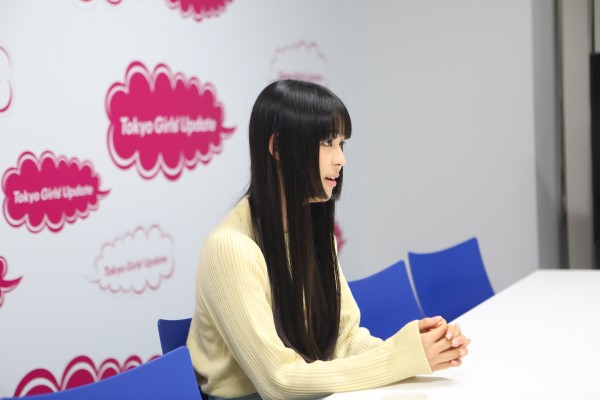
– Do other local mascots think about one another?
——ゆるキャラ同士でそんな気配りをしているんですか?
Yuffie: Local mascots consider the burden it places on their fans to become the winner of the Grand Prix. In Fukka-chan’s case, there was a kickoff party and polling stations placed around Fukaya City, and if you go to city hall they’ll tell you where they are. If you visit Fukka-chan’s local area and talk to the people there about her it would make them happy; in her local area people love her as if she were God-like. I think this is something that is uniquely Japanese, and something you don’t really see in monotheistic countries.
ゆるキャラは、グランプリになるためにファンの負担も考えてくれるんですよ。ふっかちゃんの場合は、出陣式があって、深谷市の各地に投票所が置かれて、市役所に行ったら投票をする場所を教えてくれるんです。ふっかちゃんの地元に行って、ふっかちゃんについて話すとみんな喜んでくれるし、地元の神様っぽく愛されていますよ。それは日本ならではで、一神教の国ではなかなかないことだと思います。
– Do you think many of the readers of Tokyo Girls’ Update are from monotheistic countries?
——「Tokyo Girls Update」の海外の読者は一神教の国の人が多いんですか?
Tokyo Girls’ Update: I guess most of them are.
ほとんど一神教の国の人なんじゃないかなぁ。
– Then they won’t be able to understand it overseas! (laugh)
——海外で理解されないですよ!(笑)
Yuffie: Now I’m worried. (laugh) But at handshake events, when I talk to people who have traveled a long way about their local mascots, they’re surprised like, “You know all that?!” and it makes any nervousness fade away. It’s amazing. I think loving so many local mascots is has been like a token of friendship. (laugh)
私も不安になってきました(笑)。握手会でも遠征してきた人に地元のゆるキャラの話をすると「そんなの知ってるの!?」と驚いてくれるので、そこで緊張が途切れるんです。素晴らしい。お近づきの印に、数多のゆるキャラを愛でようと思います(笑)。
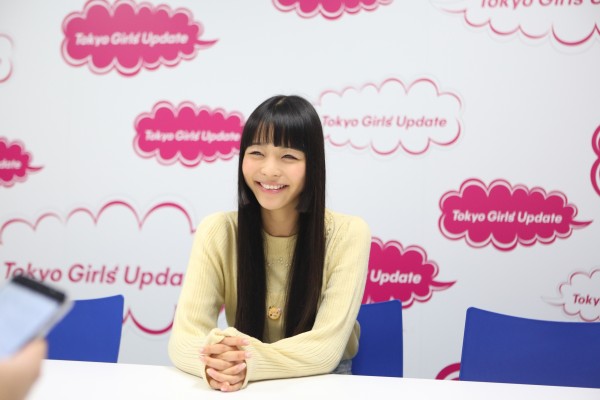
– I can’t imagine there’s a local mascot that you don’t know about. You put pictures of them on your blog and asked fans what their names were, too.
——意外なのは、ゆっふぃーが知らないゆるキャラもいることです。ブログに写真を載せて、ファンに名前を聞いているゆるキャラもいましたね。
Yuffie: There are many I don’t know about! But there are those who will tell me about them if I don’t know them, and who are happy to introduce their local characters. Usually idol and fan communication is one on one, right? But you can also communicate with local mascots as a kind of go-between.
知らない方もいっぱいいます! でも、知らないと誰かが教えてくれるし、「僕の地元のゆるキャラを紹介してくれた」と喜んでくれる人もいるんです。普通、アイドルとファンのコミュニケーションは、一対一じゃないですか? でも、ゆるキャラを媒介にしたコミュニケーションもできるんです。
– Besides you, do you know of any other local mascot and idol combos?
——ゆっふぃー以外で、ゆるキャラとアイドルの共演にはどんな事例がありますか?
Yuffie: There are local idol and mascot combos. Like Bary-san (Imabari, Ehime prefecture’s local mascot) and Himekyun Fruits Can, RYUTist and local mascots in Niigata, or Negicco and Lerch-san (local mascot in Niigata prefecture).
ご当地アイドルとご当地ゆるキャラの共演はありますね。「バリィさん」(愛媛県今治市のゆるキャラ)とひめキュンフルーツ缶さんとか、RYUTistさんと新潟県のゆるキャラたちとか、Negiccoさんと「レルヒさん」(新潟県のゆるキャラ)とか。
– Bary-san is from Ehime prefecture? I didn’t know that.
——バリィさんって愛媛県なんですか? 初めて知りました。
Yuffie: People are introduced to different local areas through their local mascots, or that’s the ideal anyways, and in that way Bary-san is admirable. (laugh).
ゆるキャラがきっかけでその地元を知ることが、ゆるキャラのあるべき姿なので、バリィさんは偉いです(笑)。
– Are you the first person in Japan to come out with a single with local mascots from around the country?
——そうなると、全国各地のゆるキャラとシングルまで出すのは、日本でゆっふぃーが初めてなのでは?
Yuffie: Besides area alone, I think this is the first time an idol has rounded up so many local mascots.
地域とはまた違う視点で、アイドルがこんなにゆるキャラを集めているのは初めてかなと思います。
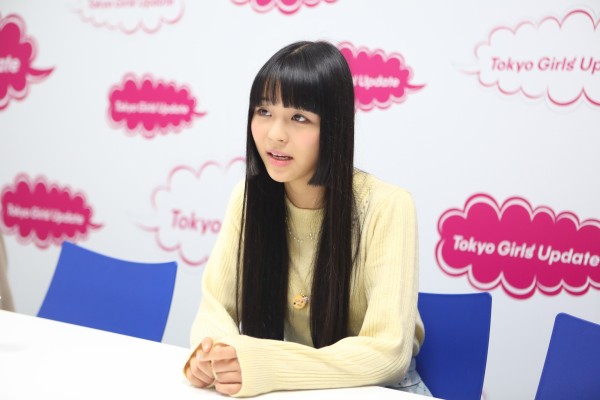
– What kind of guidelines did you use to choose which characters would be a part of Yuruffis?
——ゆるっふぃ〜ずに参加したゆるキャラの人選はどういう基準なのですか?
Yuffie: That’s difficult to say. At the very beginning Ariake Gatagoro (Ariake Sea, Saga prefecture’s local mascot) made a parody of BiS called ByS, and Yuruffis was formed as a five-member group. It was made up of Ariake Gatagoro, Fukka-chan, Sasa Dangon (a local mascot of Niigata prefecture), Unari-kun, and an understudy named Chosei Tonyu-kun (Akihabara, Tokyo’s local mascot). We would perform random concerts when we got together, so this time it was great we were able to turn that into a CD. Five new members were chosen as a power up. Being too far apart would be difficult, and they were chosen for their cuteness, friendliness, and dancing and singing.
それは本当に難しくて。ゆるっふぃ〜ずは、もともとは「有明ガタゴロウ」(佐賀県有明海のゆるキャラ)がBiSのパロディで「ByS」を作って、5体でグループを組んでいたんです。有明ガタゴロウ、ふっかちゃん、「ササダンゴン」(新潟県のゆるキャラ)、うなりくん、研究生の「ちょうせい豆乳くん」(東京都秋葉原のゆるキャラ)で。集まるとゲリラライヴをしたりしていたけど、今回CDで形にできて良かったです。今回はパワーアップさせてくれる子を新しく5体選びました。遠いといろいろ難しいし、かわいさや、仲の良さ、踊れるかや歌えるかで選びました。
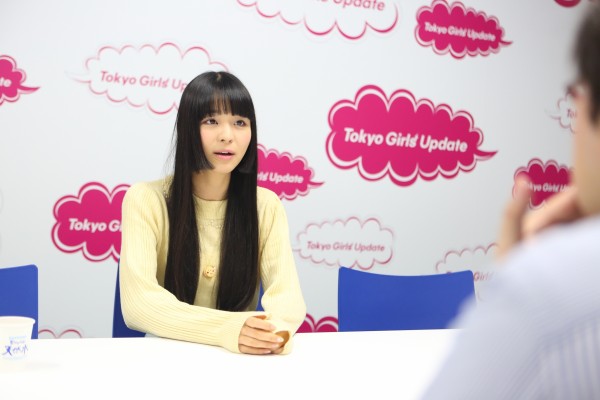
– The local mascots are singing, too?
——ゆるキャラも歌っているんですか?
Yuffie: Peccary (Bizen, Okayama prefecture’s local mascot) sings the chorus. He can’t talk, but he can sing.
「ペッカリー」(岡山県備前市のゆるキャラ)がコーラスをしています。しゃべらないんです、でも歌います。
– As far as the music goes, I get the impression that Okazaemon (Okazaki, Aichi prefecture’s local mascot) would be the type to play the theremin (an electronic musical instrument).
——音楽面では、「オカザえもん」(愛知県岡崎市のゆるキャラ)がテルミンを弾いたりしているイメージが強いです。
Yuffie: Okazaemon is much more knowledgeable about music. He even appears at Okazaki’s jazz festival, Sasakure Fest. But this time he’s our thin leader. (laugh)
オカザえもんは音楽に精通している方です。岡崎のジャズのフェスティバルや「ササクレフェス」にも出ているし。でも今回はスリム担当です(笑)。
– Do local mascots have leadership roles, too?
——ゆるキャラにも担当があるんですか?
Yuffie: The first set of members did. Fukka-chan was the honor student leader, Ariake Gatagoro was the dirty leader, Sasa Dangon was the group dating leader, and Unari-kun was the “eel guy” leader. (laugh) This time Shinjo-kun is the surrealist leader, Mikke-chan (Hirakata, Osaka’s local mascot) is the girl power leader. There are also those whose roles haven’t formally been decided. (laughs)
最初のメンバーはあったんですよ。ふっかちゃんは優等生担当、有明ガタゴロウは汚れ担当、ササダンゴンが合コン担当、うなりくんが「鰻野郎」担当(笑)。今回もしんじょう君がシュール担当、「みっけ」ちゃん(大阪府枚方市のゆるキャラ)は女子力担当。ちゃんと決めてない辺りもゆるいです(笑)。
– On November 3rd you did a solo concert at Sanrio Puroland. Do you consider those Sanrio characters to be local mascots, too?
——ゆっふぃーは11月3日に「サンリオピューロランド」でワンマンライヴをしましたね。そのサンリオのキャラクターはゆるキャラなのでしょうか?
Yuffie: That’s hard to say. There are some people who view them that way, but others who believe they’re too professional and are part of an entirely different world altogether. This time Yuruffis were invited to Sanrio Puroland and they were able to interact together. Sanrio allowed it, saying, “Our goal is to make the world come together,” so they really are gods!
そこが難しくて。ゆるキャラの頂点として見ている人もいるだろうし、プロすぎて別世界と思っている人もいると思うんですよ。今回は、サンリオピューロランドにゆるっふぃ〜ずを呼んでいいことになって、交流できることになりました。サンリオさんが「うちは世界中が仲良くなることが目標だから」と許してくれたんです、神ですよ!
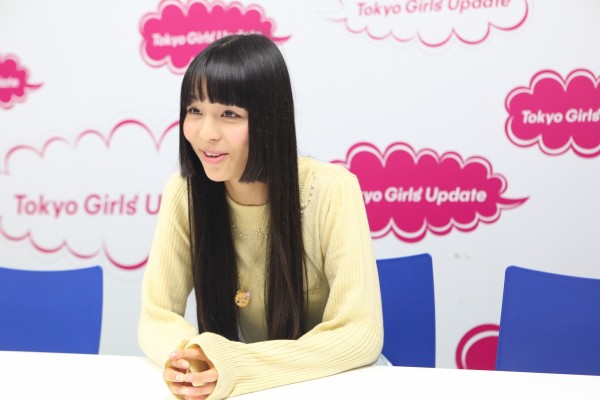
– In the MV for “Iyahaya Feeling” the local mascots appear in a public bathhouse, and the video is full of unique Japanese culture.
——「いやはや ふぃ〜りんぐ」のMVには、ゆるキャラと銭湯が登場していて、実はとても日本独自の文化に溢れていますね。
Yuffie: Showing local mascots in places you normally wouldn’t see them was part of the concept. Because local mascots don’t like water, it has a kind of mismatched feeling. On the wall of the bathhouse there’s a picture of Mt. Fuji, making for a lot of Japanese-style things in it. I think it would be great for local mascots and idols to have a worldwide reach. And now Tokyo Girls’ Update has offered to feature them so I’m glad. When comments suddenly starting coming from those abroad after uploading “Neko ni Naritai!” (single released in 2014) to YouTube, I thought it was easy for people to appreciate because it featured local mascots and a black-haired idol. I hope local mascots, bathhouses, and idols are able to reach people overseas.
ゆるキャラをふだんいない場所に連れていこうというコンセプトがあったんです。ゆるキャラは水が苦手だから、ミスマッチ感もあると思います。銭湯の壁に富士山があって、結果的に日本的なものを凝縮した感じです。ゆるキャラもアイドルも「世界にお届け!」的に出せたらいいなと思います。こういうタイミングでTokyo Girls Updateさんに載せてもらえて嬉しいです。YouTubeの「猫になりたい!」(2014年リリースのシングル)のMVに、海外から一気にコメントが来たときがあって、ゆるキャラとわかりやすく黒髪のアイドルがいるからかなと思いました。ゆるキャラと銭湯とアイドルが海外に届くといいなと思います。
– Do you consider idols, like yourself, to as something Japanese?
——ということは、「寺嶋由芙」というアイドルも日本的なのでは?
Yuffie: Oh dear, I would think so. I think idols that stand out with a strong impact like Denpagumi.inc, BABYMETAL, and LADYBABY are well-received overseas, and I hope idols that are different from that will also be well-received. If I were to go abroad I wonder if they would see me as too plain or as something new…?
いやはや。それも思いますよ。でんぱ組.incさんやBABYMETALさん、LADYBABYさんみたいなインパクトが強くてヴィヴィッドな感じのアイドルが海外で受けている中で、別の切り口のアイドルにも気づいてくれたらいいなと思います。もし私が海外に行けたとしたら、地味なのかな、逆に新鮮なのかな……?
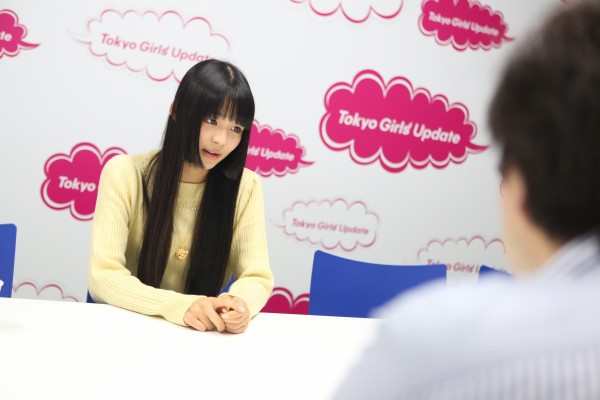
– Your graduation thesis dealt with the theme “local mascots as ‘stories”. I get the feeling “Iyahaya Feeling” ties into that.
——ゆっふぃーの大学の卒論は、アイドルとゆるキャラをテーマにした「『物語』としてのゆるキャラ」でした。「いやはや ふぃ〜りんぐ」は、その実践編という感じですね。
Yuffie: I really think so, too. I was glad I was able to organize my thoughts at the time. I’m glad I didn’t try to write about Japanese literature just to look cool. (laugh)
それはすごく思います。あのタイミングで考えていたことを整理できて良かったです。かっこつけて国文学について書かなくて良かったです(笑)。
– What kind of audience would you like “Iyahaya Feeling” to be heard by?
——「いやはや ふぃ〜りんぐ」はどんな人に聴いてほしいですか?
Yuffie: I want local mascot fans to listen to it. I want them to be reminded of just how cute local mascots are. I also want idol otaku to get to know the appeal of local mascots. …Which is why I put it out. (laugh) I couldn’t make local mascots a huge thing at my school, but my otaku fans understand, so those who are interested should go and educate themselves about them. (laugh)
ゆるキャラファンに聴いてほしいです。「ゆるキャラがこんなにかわいいのか」と再発見してほしいです。アイドルオタクにもゆるキャラの魅力を知ってほしいな。……何のために出すんだと(笑)。ゆるキャラの話題は学校では通じなかったけれど、私のオタクとは通じるから、趣味の仲間は自分で教育して作ればいいんですよ(笑)。
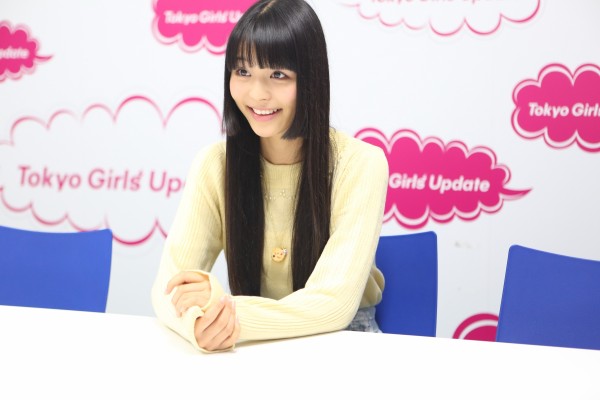
– I certainly feel as if I’ve learned a lot about local mascots while reading your Twitter and blog…
——たしかに、ゆっふぃーのTwitterやブログを読んでいるうちに、ゆるキャラをたくさん覚えました……。
Yuffie: Well done! (laugh) There hasn’t been anything yet as cute as this MV we’re putting out, it has a bright and fun melody, and everything is emphasized in the hopes that even small children will listen to it. I thought it would be good for an otaku to make something that’s sparkly and happy.
よくできまきた!(笑)こんなに「かわいい!」と押し出したMVはなかったし、明るく楽しい曲調だし、小っちゃい子も聴いてくれるかもしれないからわかりやすさも重視しました。キラキラでハッピーな感じをオタクと作っていけたらいいなと思います。
– On that note, do you think the local mascots operate in the same way as the idol business?
——ところで、ゆるキャラにもアイドルのように運営っているのですか?
Yuffie: I think it depends on the local mascot. But I think local mascots have continued this far because of the amount of love in the business. There’s really a lot of love behind Fukka-chan’s management. I think as far as having love behind their businesses, local mascots and idols are the same.
ゆるキャラによりますね。でも、運営がゆるキャラに愛を持っているほど長続きするんですよ。ふっかちゃんの運営は本当に愛を持っているんです。運営が愛を持っていたほうがいいのは、ゆるキャラもアイドルも一緒なんですよ。
Buy CD here:
—
—
—
Related Links:
Yufu Terashima Official Website:https://yufuterashima.com
Yufu Terashima Official Twitter:@yufu_0708
Photo by kobadog
Translated by Jamie Koide


